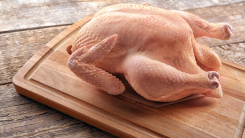All the Food Safety Questions You’ll Have on Thanksgiving Day, Answered

Family disagreements at Thanksgiving aren’t limited to politics at the dinner table: If you’ve ever stood in the kitchen arguing with your grandma about whether the turkey is done, you know what we mean. So we asked food safety expert Ben Chapman to settle your most likely disputes.
Can I wash this drippy juice off my raw turkey?
window.videoEmbeds = window.videoEmbeds || []; window.videoEmbeds.push({
elemId: ‘video-container-JZXDotD4p9c’,
data: {“slug”:”JZXDotD4p9c”,”start_time”:0,”url”:”https://www.youtube.com/watch?v=JZXDotD4p9c”},
videoPlayerType: ‘in-content’
});
This is an easy one: no. Your raw turkey may be covered in germs, but rinsing is “not removing anything, just spraying it around your kitchen,” Chapman says. Tiny droplets of germy water can end up on surfaces three feet away.
The advice holds even if the turkey is covered in an unidentifiable slime. That’s actually a biofilm of stuck-together bacteria, and washing won’t completely remove it anyway. Those germs are perfectly safe to leave on the turkey because, remember, you’re going to cook it.
If the bird is covered in blood or feather bits, Chapman recommends wiping the turkey with either a paper towel (which you throw away afterward) or a kitchen towel (which you throw straight into the washing machine.) That will remove the gross stuff without spraying bacteria everywhere.
How do you tell when the turkey is done?
window.videoEmbeds = window.videoEmbeds || [];
window.videoEmbeds.push({
elemId: ‘video-container-Oa_EeaRNV-8’,
data: {“slug”:”Oa_EeaRNV-8″,”start_time”:0,”url”:”https://www.youtube.com/watch?v=Oa_EeaRNV-8″},
videoPlayerType: ‘in-content’
});
With a thermometer, of course. The color of the meat or juices tells you nothing about doneness, as this guide explains: juices may run pink or clear depending on how stressed the animal was at the time of slaughter (which changes the pH of the meat). The color of the bone depends on the age of the bird at slaughter. And pink meat can depend on roasting conditions or, again, the age of the bird. It’s possible to have pink juices, meat, or bones even when the bird is cooked, or clear juices even when it’s not done yet.
So you’ve got your thermometer. What temperature are you targeting? Old advice was to cook the turkey to 180 degrees Fahrenheit, but that was a recommendation based partly on what texture people liked in their meat, Chapman says. The guidelines were later revised to recommend a minimum safe temperature, regardless of what the meat tastes like, and that temperature is 165. You can cook it hotter, if you like, but that won’t make it any safer.
There’s a way to bend this rule, though. The magic 165 is the temperature that kills Salmonella and friends instantly, but you can also kill the same bacteria by holding the meat at a lower temperature, for a longer time. For example, you can cook your turkey to just 150 degrees, as long as you ensure that it stays at 150 (or higher) for five minutes, something you can verify with a bluetooth thermometer like an iGrill. This high-tech thermometer stays in your turkey while it cooks, and sends data to your smartphone. Compare its readings to these time-temperature charts for poultry to make sure your turkey is safe.
Do I have to wash the vegetables for the salad? What about the vegetables I’m going to cook?
Washing raw vegetables is “risk reduction,” Chapman says, not a guarantee of safety. Washing a head of lettuce can remove 90% or maybe as much as 99% of harmful bacteria, but the 1% that’s left is still able to make you sick. When outbreaks of foodborne illness are traced back to fruits and vegetables (the number one source of such illnesses, actually), they have high enough levels of bacteria that washing wouldn’t have helped much.
Cooking kills those germs reliably, so you don’t have to wash vegetables you plan to cook. You might want to give them a scrub if they’re covered in dirt, but if they look clean, they’re good to go. Wash them if you want, but if you’re pressed for time, why worry about it?
If I cut raw meat on this cutting board, then wash it in soap And water, is it safe to use again?
Almost, says Chapman: There’s one more step. After washing the cutting board, you have to let it dry.
For everyday use, that’s no problem: Cut your food, wash the board, and stick it in the drying rack (or just use the dishwasher) and it will be ready the next time you make dinner. On turkey day, though, Chapman says he uses multiple cutting boards, since there isn’t always enough time for a single re-used board to dry.
In that case, he recommends designating one set of boards for raw meat and vegetables that will be cooked, and a separate board for prepared foods that are already cooked and headed for the table.
It’s been more than two hours. Have the leftovers gone bad?
Not necessarily, but it’s a good rule of thumb. The recommendation for home cooks like you and me is to get food from oven to fridge within two hours.
This is due to a microbe called Clostridium perfringens that may not be totally killed off by cooking. Although live C. perfringens don’t survive cooking, they make heat-resistant spores—think of them as eggs that can later hatch baby bacteria. After a few hours hanging out on room-temperature turkey, the spores will hatch and the bacteria multiply, and they can make a heat-resistant toxin that can make you sick. The total time from oven to bacterial takeover: about four hours.
So you can technically leave leftovers out for four hours at room temperature, Chapman says, but the two-hour rule was created to give you a nice safety margin, in case you weren’t standing by the stove with a stopwatch. If you aim for two hours, and get them in by three, you should be okay.
Do I have to cool the leftovers before putting them in the fridge?
Nope, that’s an outdated rule, Chapman says. Old refrigerators could be overwhelmed if you stuffed a lot of hot food in at once, but that’s not a concern with anything made in the last couple decades. The best practice is to cool the food as quickly as possible: as soon as you know you won’t be eating something, stick it in the fridge.
Chapman says when he carves a turkey, he puts meat destined for leftovers into Ziploc bags before he even serves the meal. Splitting it into small packages helps it cool faster. After dinner, he packs up the rest of the meat the same way.
And make sure your refrigerator is set to the right temperature, he cautions. Check it with a thermometer: it should be below 41 degrees Fahrenheit, and preferably closer to 32. The colder your fridge, the longer food will last.
The main danger in refrigerated leftovers is Listeria, a bacterium that can grow at refrigerator temperatures. The food is good for three or four days, so if you’re hankering for turkey sandwiches on Monday, you can re-cook your leftovers to kill Listeria. Reheating kills this pathogen, but not C. perfringens—which means reheating can’t salvage food that was left out too long on Thursday.



